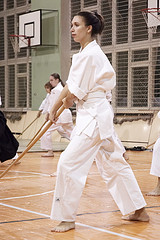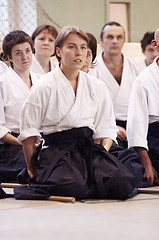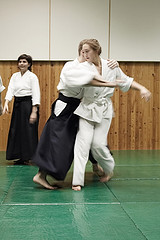Aikido, violence against women, and my daughter’s sensei
Prompted by a discussion with my daughter’s sensei I felt a need to review some violence against women stats. All images in this post are by fotografer.ru.
Check this out:
in Canada, from WAVAW:
- One half of all Canadian women have experienced at least one incident of sexual or physical violence. Almost 60% of these women were the targets of more than one of these incidents. (Statistics Canada, “The Violence Against Women Survey,” The Daily, November 18, 1993.)
- One in four Canadian women will be sexually assaulted during her lifetime. In BC this number is almost double(47%). ( J. Brickman and J. Briere, “Incidence of Rape and Sexual Assault in an Urban Canadian Population,” The International Journal of Women’s Studies, Vol. 7, no. 3, 1984.)
- Sexual assault is not most often committed by strangers who jump out of bushes or wait in alleys for their victims. Over 80% of sexual assaults are committed by someone known to the victim.
- Most assaults occur in a private home (60%) and the largest percentage of these occur in the victim’s home(38%). (D. Kinnon, “Report on Sexual Assault in Canada,” Canadian Advisory Council on the Status of Women, Ottawa, 1981.)
- Studies of rapists show that rapists are “ordinary” or “normal” men. The majority of convicted rapists assaulted for the emotion gratification they received from the violent act, not out of sexual frustration. (Helen Lenskyj, “An Analysis of Violence Against Women: A Manual for Educators and Administrators,” Toronto: Ontario Institute for Studies in Education, 1992.)
- Men who commit sexual assault come from every economic, ethnic, racial, age, and social group. As well, women who are sexually assaulted are from every economic, ethnic, racial, age, and social group.
- Legally, women have the right to say ‘no,’ to any form of sex with anyone, including their spouse or the person they are dating. Sexual assault within relationships has been illegal in Canada since 1983, however many people still do not recognize it as a crime. Even within a relationship, each partner must give consent each time sexual relations occur.
- Legally, a woman has the right to change her mind about having sex at any point of sexual contact. If her partner does not stop at the time she changes her mind and says ‘no,’ this is sexual assault. As well, just because a woman is in a relationship with someone or has sex with a person before, does not mean that person cannot assault her. Consent must be given every time two people engage in sexual contact.
- According to Statistics Canada, in the year 2000, sexual assault came in third for the highest number of violent crimes committed in Canada. The number of assaults committed accounted for the highest number of violent crimes.
- Anyone can be sexually assaulted. However, most sexual assaults that occur are against women and are perpetrated by men.
and in the United States, from the Kansas District Attorney’s office website:
- Domestic violence is the leading cause of injury to women between the ages of 15 and 44 in the United States; more then car accidents, muggings and rapes combined.
“Violence Against Women, A Majority Staff Report,” Committee on the Judiciary, United States Senate, 102nd Congress, October 1992, p. 3- About 1 out of 4 women are likely to be abused by a partner in her lifetime.
Sara Glazer, “Violence Against Women” CQ Researcher, Congressional Quarterly, Inc., Volume 3, Number 8, February, 1993, p. 171- One women is beaten by her husband or partner every 15 seconds in the United States
Uniform Crime Reports, Federal Bureau of Investigation, 1991.Three to four million women in the United States are beaten in their homes each year by their husbands, ex-husbands or male lovers.
“Women and Violence,” Hearings before the U.S. Senate Judiciary Committee, August 29 and December 11, 1990, Senate Hearing 101-939, pt. 1, p. 12.- Women of all cultures, races, occupations, income levels and ages are battered by husbands, boyfriends, lovers and partners.
For Shelter and Beyond, Massachusetts Coalition of Battered Women Service Groups, Boston, MA 1990.
I’ve seen these state before. And I figured someone who teaches defense classes would be familiar with them too.  But sometimes, just when you think someone is all enlightened and that there’s hope for the planet you talk to them and you find out that enlightenment is categorical. They may be great at meditating and teaching traditional techniques but when it comes to applying it to the contemporary world maybe it’s more abstract and theoretical than useful in a practical way. I’ve discovered that there’s a divide between the theory and practice of aikido…
But sometimes, just when you think someone is all enlightened and that there’s hope for the planet you talk to them and you find out that enlightenment is categorical. They may be great at meditating and teaching traditional techniques but when it comes to applying it to the contemporary world maybe it’s more abstract and theoretical than useful in a practical way. I’ve discovered that there’s a divide between the theory and practice of aikido…
My daughter has been doing aikido for about a year and a half now. She loves it. There are lots of girls in her class of age 10-13 kids and although most of the adults are male there are 2 adult-late teens women with black or brown belts who assist and make good role models along with the men who are also great at what they do. I’ve talked to the sensei on several occasions and he’s got a great philosophy of teaching and the kids love him. I think the classes are valuable for her. It’s just really unfortunate that sensei’s knowledge about the type of violence women face isn’t all that current.
Actiongirls has been talking about the various self-defense courses available around campus and nothing has really caught our fancy yet. I knew that sensei had started teaching some  self-defense classes for women for the parks and rec department and approached him about maybe doing an one day workshop for our club. We specifically want strategies for dealing with the most common type of attacks that women face – not the ones that are perpetuated in myths. So I told sensei that the members of the club want to learn to protect ourselves for real life situations, for example, in a car or in bed — to which he replied “woooahh what are you doing in bed with someone then?” Uh duh?? most women do not planned to be raped. I mean, if we did, maybe we could just change our plans and stay home and bake.
self-defense classes for women for the parks and rec department and approached him about maybe doing an one day workshop for our club. We specifically want strategies for dealing with the most common type of attacks that women face – not the ones that are perpetuated in myths. So I told sensei that the members of the club want to learn to protect ourselves for real life situations, for example, in a car or in bed — to which he replied “woooahh what are you doing in bed with someone then?” Uh duh?? most women do not planned to be raped. I mean, if we did, maybe we could just change our plans and stay home and bake.
So sensei told me about purse snatching strategies and parking garages and walking down the street defense techniques, saying women need to use their brains and not put themselves in dangerous situations, this being the best way to not get attacked. Good grief. Blame the victim and disregard that the majority of attacks take place in the home with someone the woman knows.
So no, sensei wasn’t arguing with me but just telling me what he teaches. Too bad it’s  not going to be useful to the majority of women and ignores the violence against women stats. The problem is that a sensei is an authority figure. People listen to him – especially his students. If a woman takes his self-defense class and he tells her to avoid walking down the sidewalk, going to parking garages, and other “dangerous places” she might do this. But it tells her it’s her own fault for being a woman, perpetuates stereotypes of women needing protection, and gives her a false sense of security that now that she can escape a purse snatcher she is “safe”. It’s not going to help her at all for the types of attacks she is most likely to face. In this regard, sensei is misleading.
not going to be useful to the majority of women and ignores the violence against women stats. The problem is that a sensei is an authority figure. People listen to him – especially his students. If a woman takes his self-defense class and he tells her to avoid walking down the sidewalk, going to parking garages, and other “dangerous places” she might do this. But it tells her it’s her own fault for being a woman, perpetuates stereotypes of women needing protection, and gives her a false sense of security that now that she can escape a purse snatcher she is “safe”. It’s not going to help her at all for the types of attacks she is most likely to face. In this regard, sensei is misleading.
We’re still looking for a useful self-defense class. One that doesn’t blame women and prepares them for the type of violence they are actually likely to face. If anyone has a recommendation I’d be happy to have it. Maybe there are materials so we could do our own?
Thanks again to fotografer.ru for the great CC-licensed photos.

Heya, I just followed a link back here from your recent comment on the shrub.com blog – hope this doesn’t seem intrusive!
I’m a martial arts instructor, myself, and a woman, which I think gives me some perspective on the sorts of things you’re discussing in this post. ;-) It’s true that most self-defense courses (and self-defense segments in regular martial arts courses) focus on defending against the kinds of attacks that women are -least- likely to ever encounter. I think in large part that’s because those are the easiest sorts of attacks to teach a defense against, really, for a variety of reasons, and also because there’s really a ton of ignorance about what sorts of attacks the average woman is likely to face, as you suggest.
I was lucky enough to get involved in the formation of a local group of women black belts a few years back, which came together for the express purpose of designing a blended-discipline self-defense seminar for women that could be taught in one day and would have wide applicability. We came up with a pretty good curriculum, and had some good learning experiences along the way. I’d be happy to talk about the specific issues we tried to address, and some of the solutions we came up with through email or something, if you like, and maybe you could use that information to help some local martial artists develop a similar program in your area? (I’m assuming here that your area and my area are not the same – I’m in Tucson, Arizona) Feel free to email me if you like.
This looks like a really interesting blog, btw – I’ll have to bookmark it and come back later to check it out more fully!
Revena: thank you and welcome. I’m so happy to hear your comments, that there are people who take this seriously and that there are people designing something useful. I would love to hear how your group is addressing these issues and what you’ve come up with so far. I will email!
What a great post! I’ve never thought of it in those terms before, but you make a very valid point.
I would say Muay Thai or Systema (with a combination of Ki Aikido) are both good martial art options. I think it is not the art, perhaps, but the way it is implemented. Some are just more appropriate than others perhaps.
Muay Thai — on account that the practitioner has proficient use of knuckles, elbows, shins, and knees (enough to cause serious damage to an assailant with one blow) — is probably one of the most practical hard martial arts and is known to be very good for self defense.
Systema is an art of Russian origin taught to Special Operations (specnaz). It takes into account hundreds of possibilities (ie fighting in the dark, against multiple opponents, while tied, while lying down, while being thrown against a wall,…etc and in virtually any position against any sort of opponent). There are no “fixed” or “repetitive” movements because each time the situation could be different, so students learn to improvise and remain calm based on any situation, all while learning about the human anatomy/physiology, physics, and psychophysics.
Ki Aikido is useful because it helps one think clearly and calmly. A woman — and anyone really — can defend themselves a lot better against anyone if they practice breathing and alternate techniques offered by Ki Aikido (Shin Shin Toitsu).
Cheers.